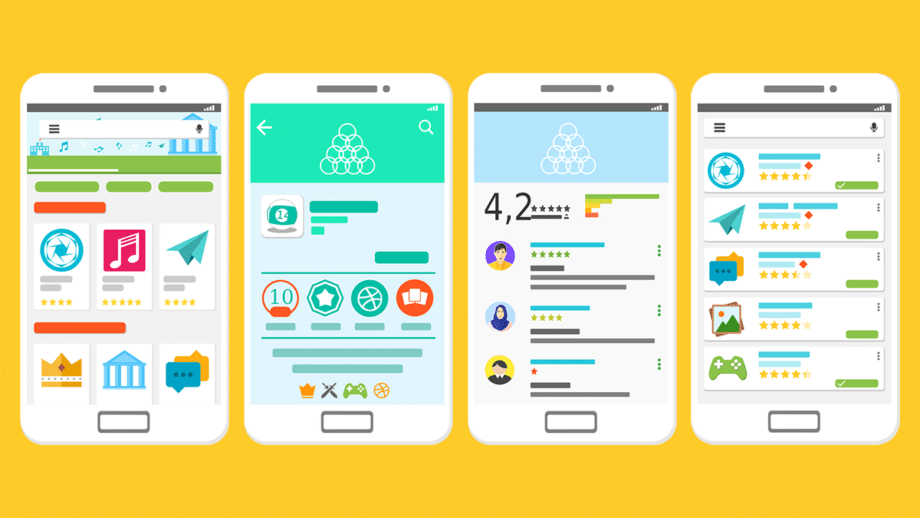Building a mobile app means joining the gold rush as apps are gaining attention from everywhere. There’s a fact- you cannot judge the book by its cover. When you turn the pages, you get to know that a large percentage of apps are uninstalled after a day. The reason behind this is the fierce competition created due to the development of hundreds of mobile apps serving the same purpose.
Making your mobile app survive and not die brutally requires paying attention to a couple of things that are often overlooked. This ignorance or mistake is not at all tolerated by the target users when they have multiple options on the app stores and play stores. If as an appreneur, you don’t want your unique app idea to fail and hit the mark of millions of downloads, avoid making these mistakes for phenomenal results.
Top Mobile App Development Mistakes That You Should Avoid

Avoiding mobile app development mistakes increases the chances of creating a successful and well-received app that meets user expectations and drives positive outcomes. Here are the mistakes that you should not make at any cost.
Related: Mobile App Development: The Complete Guide.
1. Poor Planning
The most common mistake businesspeople make is not planning the development of their mobile app well. Lack of planning leads to project scope creep and cost/time overruns. It is important to define the clear goals, expectations, and an app development roadmap upfront before starting the mobile app development process.
To prevent these kinds of mistakes, establish objectives that define what you are seeking to accomplish by building a mobile app. It’s useful in compiling an app’s winning ingredients. Additionally, the delivery time and app development costs are predefined to make executions smoother by reducing the chances of a project extension.
2. Ignoring User Research
Forgetting to do good user research can leave you with an app that does not meet the needs and wants of your audience. It’s like a shot in the dark to assume users’ needs for mobile applications.
Knowing who your users are, what they do, and what their problems or needs are is indispensable for creating a user-centered app that speaks to your audience. To avoid these mistakes and to detect the earlier inconsistencies that save businesses from unnecessary efforts, conducting a discovery workshop is extremely beneficial. That is why to guarantee a successful project rolling on the development floor, most of the outsourcing mobile application development agencies advise you having a discovery workshop to research target users’ needs.
3. Lack of Platform Consideration
Ignoring platform-specific design and functionality requirements while building cross-platform apps (iOS/Android) may result in poor user experience. Apps should meet the design principles and conventions of their platforms.
Not adhering to platform-specific guidelines can lead to bad usability and user unhappiness. Resist the urge to enhance app accessibility by building multi-platform apps, preferring instead to build an app for one platform and then incrementally port it.

4. Poor Performance Optimization
Slow load times, UI freezes or crashes are the types of performance issues that can cause users to become frustrated and abandon an app. Performance optimization failure can arise from poor coding practices, resource-heavy features, or insufficient tests.
Besides good coding techniques, caches, and effective test coverage, to offer a good user experience we need to care about app performance. In addition, by reducing the waste of resources, using app bundles, and creating less code that boosts performance, we can minimize the size of their app.
5. Neglecting User Interface (UI) and User Experience (UX)
Bad UI/UX can make the app hard to navigate and understand, leading to a lack of completion as well. Overlooking UI/UX can lead to unclear layouts, inconsistent design elements, and non-intuitive interactions. It has been labeled as one of the leading causes for app uninstallation.
By putting the money into a well-designed UI/UX, emphasizing simplicity and user-friendly design – neatness but with grace – you’ll improve user satisfaction and interaction. Also, the usage of the latest UI/UX design guidelines and best practices allows us to create an extraordinary UI/UX design that would strike users’ minds.
6. Skipping Beta Testing
Releasing an app live without sufficient beta testing may result in hidden bugs, bad usability feedback, and poor user ratings. Surprisingly, 58% of crashes on iOS were due to insufficient testing. Beta testing is the process of giving out a pre-launch version of the app to a small group of users, getting their feedback and identifying bugs.
Ignoring this critical step can harm an app’s reputation, lead to bad reviews, and negatively impact user adoption. So, by running beta testing, agencies for developing mobile apps are trying to prepare them for the actual release and win the favor of their targeted audience.
See also: 15 Big Challenges in Mobile App Development You Need to Know.
7. Inadequate Security Measures
Can you believe 50% of apps with five to ten million downloads have a vulnerability? It signifies not putting strong security controls in place can expose user data to vulnerabilities and breaches. Mobile applications often deal with critical user data such as personal information and financial transactions. When it gets stolen or tampered with by hackers, not only users’ data but the business brand image is ruined which can’t be fixed.
By incorporating encryption, strong authentication schemes, and good security practices, you can ensure the integrity of your user data and build trust with your audience.

8. Poor Onboarding Process
A difficult or unclear onboarding experience can prevent users from staying in the app. The app should have a clear value prop that is quickly understood by the user and an initial setup flow that very smoothly guides the user through its steps.
Creating a smooth and intuitive onboarding experience with clear instructions and tooltips can increase user retention. Apps with personalized onboarding retain 50% more users. Remove the forced sign-up before browsing and let them Rate it as Keep It or Not.
9. Lack of Regular Updates and Maintenance
Mobile app development is an ongoing process. Instead, it’s a continuous update process that needs to be followed for mobile app or web content updates. Failing to deliver regular updates and bug fixes can lead to an outdated app plagued by compatibility problems, security risks, and decreasing user happiness.
It’s necessary to respond to user feedback and bug reports and provide regular updates as well as new functionality. Continuous maintenance keeps your app up-to-date, reliable, and secure.
10. Not Considering User Feedback
User feedback can be a great asset for getting to know how your application is being perceived and experienced by the users. Neglecting user feedback and not taking care of user issues can result in reduced customer satisfaction and loyalty. By actively listening to user feedback – through online app reviews, customer support channels or the feedback forms themselves – you can gain valuable insights for app improvements.
By interacting with and responding to users and iterating on their feedback for the better of the app fosters good user experience and loyalty.

11. Overloading Features
In most cases, businesses make the app specific to a niche and try to make it a one-stop-shop for all user’s needs. So, they “feature-creep” it. The consequence of squeezing in a plethora of features into the mobile app would result in cluttered interfaces, performance issues, increased development time & cost, and confused users.
Give importance to key features that suit your mobile app’s core purpose and deliver the desired user experience. It can mean better resource allocation, an easier learning curve, no feature-heavy app updates, and maintenance management by staying at the cutting edge and getting a competitive advantage.
12. Lack of Offline Functionality
Lacking offline functionality can result in bad UX and interfere with app usability when it matters. Assume users are in a situation with limited, slow, or no internet connection. With offline functionality, the app works even in areas with poor network coverage.
It improves app performance, as the app can load faster (because it doesn’t have to retrieve data from a remote server). Besides, for apps dealing with sensitive data, it becomes a good deal, as localized data storage is less exposed to potential cyber threats giving them improved privacy and security. To sum up, offline mode in a mobile app improves user experience, usability, and dependability.
13. Rushing the Release
Launching an app too soon without proper testing and polish can result in a bad first impression and user churn. A badly executed app release can even tarnish the business’s reputation and value. Users can see this as unprofessional or unreliable and lose trust in the brand, losing out on sales opportunities.
Organizations need to invest the effort in researching, building, and testing their app properly for better chances of success, good reviews, and better user journeys. Moreover, regulatory compliance requirements may have to be fulfilled based on the type and audience of an application. Ignoring these compliance steps can be fatal for your app in the future, and a hasty release might overlook them.
Related: 15 Best Mobile App Development Tools to Help You Out.
Conclusion

The common mobile app development mistakes are now revealed, which you should keep in mind while building your next mobile application. Adhering to the best practices at every stage of the mobile app development process and having the right development team helps you get the app that the target users are looking for. You can also consider the mobile app development guide that provides details extensively for how to get everything right during and after the creation of the mobile app. All things together would help you come up with an innovative mobile app development solution that delights your customers and takes your business to new heights.





